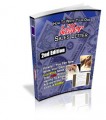Salespage Snapshot

Table of Contents
Introduction . 5
What is Kombucha? 5
Easy to Make …. 6
Variety of Flavors … 6
Good Soft Drink Alternative …. 7
Low in Caffeine . 7
Relaxing . 8
Healthy .. 8
Chapter 1 – History Of Kombucha Tea 10
First Mention .. 10
Dr. Kombu 11
Russia and Beyond …. 11
World War II … 12
Chernobyl . 12
Modern Popularity 13
Chapter 2 – The Mother (SCOBY) . 14
What is SCOBY? … 14
Culture 15
Bacteria and Yeast Found in SCOBY . 16
Growing Your Own SCOBY …. 16
Chapter 3 – Is Kombucha Right For Me & Is It Safe .. 18
It’s a wild ferment. …. 18
It’s a biosorbent. .. 19
It Contains Unmeasured Amounts Of Alcohol. .. 20
It Contains Sugar. 20
Bottom Line …. 21
Benefits Of Kombucha & Does It Live Up To The Hype … 22
1. Probiotics … 22
2. Antioxidants …. 23
3. Anti-Bacterial … 24
Other Benefits of Kombucha Tea 25
Side Effects . 26
Alcohol Buzz … 26
Improved Digestion … 27
Improved Mental State … 27
Lowered Blood Sugar . 27
Yeast Infection 28
Acidosis …. 28
Liver Damage . 28
Diarrhea…. 29
Sample Content Preview
which can help with digestive issues, antioxidants which can help remove toxins from your body, and B vitamins which help in a number of ways within your body. It’s also low in sugar, calories, and sodium, making it great for people who are trying to lose weight.
Well that’s a basic overview of what Kombucha is and why it’s gaining notoriety as a miracle elixir for overall health In the next part we’re going to take a look at the history of Kombucha and how it’s evolved over time Let’s dive in…
Chapter 1 – History Of Kombucha Tea
Nobody knows for sure how far back kombucha goes, and the truth has been so mixed with legends over the years that it’s hard to separate them now. But, we’re going to do our best to present you with the history of kombucha tea and how it came all the way from an ancient Chinese medicinal drink to a modern-day health beverage around the world.
First Mention
The first recorded mention of kombucha goes back to 220 BC during the Qin Dynasty in China. It was said to have been used as a drink of immortality for Emperor Qinshi Huangdi. This is likely where it gets the “cha” part of its name as the Chinese word for tea is “cha.” The Chinese had many other names for this drink as well such as “stomach treasure,” “sea mushroom,” and “tea mold.”
Dr. Kombu
Supposedly, in the year 414 AD, a Korean doctor by the name of Dr. Kombu brought the drink to Emperor Inyoko of Japan, and this is where the drink gets its name. However, there isn’t enough evidence to back up this story, so it could be the stuff of legends. Another story is that Ghengis Khan carried kombucha with him as he traveled.
Russia and Beyond
From Asia, kombucha found its way to Russia as well as Europe, where it not only gained in popularity until the 19th century, but also gained a few more names, such as in Russia where it is referred to as “tea mushroom.” According to one account, this beverage saved the life of Alexsander Solzhenitsyn, a Nobel Prize winner, while he was in exile in Siberia.
World War II
Kombucha continued to be popular throughout Europe and Russia until the beginning of World War II. This was because both tea and sugar were rationed and it was too hard for the average citizen to get their hands on enough of them to regularly make the drink. After the war, however, it began to grow again in popularity, and saw a surge in the 1960’s when Swiss researchers proved its health benefits.
Chernobyl
In the 1980’s, there was a horrific accident near Chernobyl in Russia where a nuclear plant melted down, exposing hundreds of people nearby to radiation. There was a group of people made up primarily of elderly women, however, that survived and did better than the others. It was found by the scientists and doctors that these people regularly drank kombucha.
Modern Popularity
Since the year 2000, kombucha has become a popular health drink throughout the Western world, with people all over Europe, the United States, and Australia enjoying its numerous health benefits. Unfortunately, as many hail this drink as a miracle cure for a number of ailments, others claim it to be dangerous. Because it is created through a natural process and cannot be patented, big companies have little interest in it, which is why there have been few studies done on kombucha to provide completely conclusive evidence one way or the other.
Now that we’ve uncovered what Kombucha is and the history of this tea, the next thing to do is explain how it’s made…more specifically the SCOBY (Mother), which is what we will cover in the next part.
Chapter 2 – The Mother (SCOBY)
What sets kombucha apart from every other health drink out there is the process by which it is made. That process begins with something that is most commonly referred to as SCOBY, but may also be called “kombucha mushrooms” or “kombucha mothers.” These mothers are responsible for the fermentation process that turns tea into kombucha.
What is SCOBY?
SCOBY stands for Symbiotic Culture Of Bacteria and Yeast. During the brewing process, it can be found floating on the top of the kombucha, and is removed before bottling. It is disc-shaped and has a gooey consistency and appearance that is unappealing to many people. But, if you want to brew your own kombucha, then you need SCOBY to do it!
Other Details- 1 Ebook (PDF, DOC), 29 Pages
- 1 Audio (MP3)
- 1 Graphic (PNG)
- 1 Squeeze Page (HTML)
- Year Released/Circulated: 2020
- File Size: 7,133 KB
License Details:
You’re granted master resell rights, resell rights or to resell with personal use rights.
You may add this product to your PAID membership site
You may giveaway the product as a bonus when people buy through your affiliate link
You may edit the included opt-in / squeeze / landing page
You may giveaway the eBook for Lead Generation purpose
No, you may NOT edit the contents of the eBook
No, this product does NOT include private label rights. You are granted Master Resell Rights only














